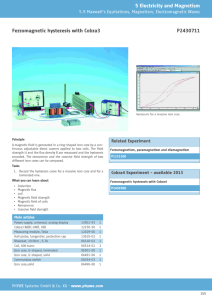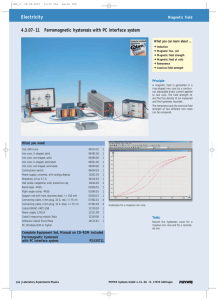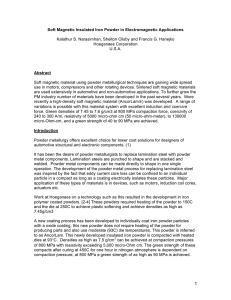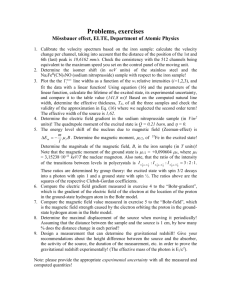Growth Opportunities with Soft Magnetic Materials
advertisement
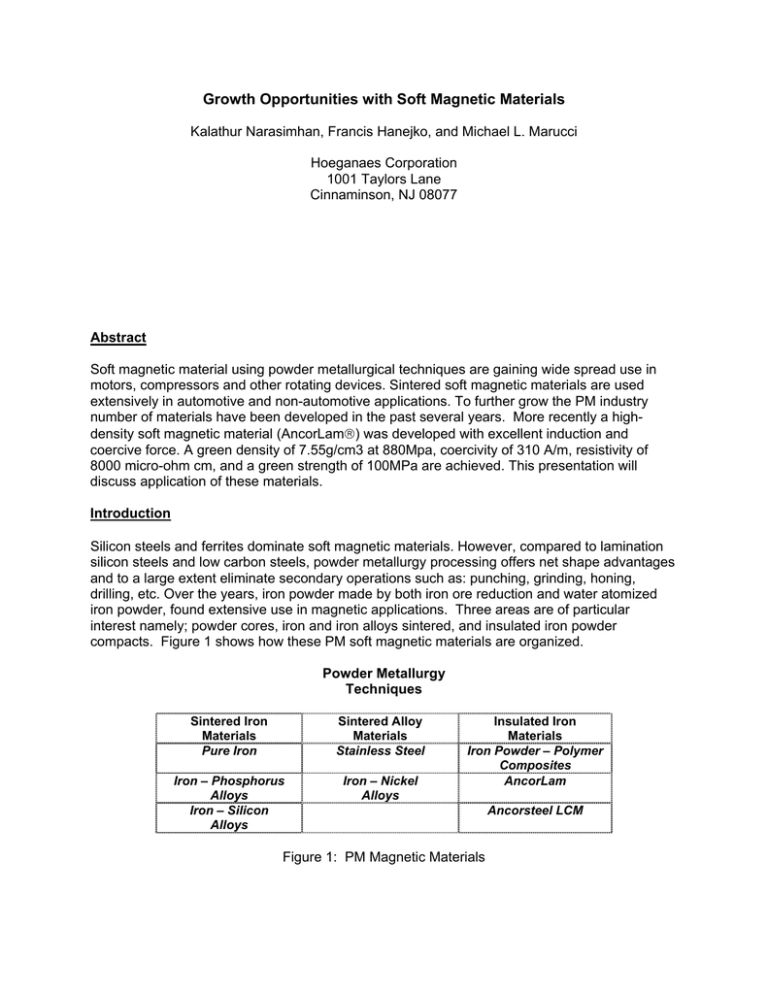
Growth Opportunities with Soft Magnetic Materials Kalathur Narasimhan, Francis Hanejko, and Michael L. Marucci Hoeganaes Corporation 1001 Taylors Lane Cinnaminson, NJ 08077 Abstract Soft magnetic material using powder metallurgical techniques are gaining wide spread use in motors, compressors and other rotating devices. Sintered soft magnetic materials are used extensively in automotive and non-automotive applications. To further grow the PM industry number of materials have been developed in the past several years. More recently a highdensity soft magnetic material (AncorLam®) was developed with excellent induction and coercive force. A green density of 7.55g/cm3 at 880Mpa, coercivity of 310 A/m, resistivity of 8000 micro-ohm cm, and a green strength of 100MPa are achieved. This presentation will discuss application of these materials. Introduction Silicon steels and ferrites dominate soft magnetic materials. However, compared to lamination silicon steels and low carbon steels, powder metallurgy processing offers net shape advantages and to a large extent eliminate secondary operations such as: punching, grinding, honing, drilling, etc. Over the years, iron powder made by both iron ore reduction and water atomized iron powder, found extensive use in magnetic applications. Three areas are of particular interest namely; powder cores, iron and iron alloys sintered, and insulated iron powder compacts. Figure 1 shows how these PM soft magnetic materials are organized. Powder Metallurgy Techniques Sintered Iron Materials Pure Iron Sintered Alloy Materials Stainless Steel Iron – Phosphorus Alloys Iron – Silicon Alloys Iron – Nickel Alloys Insulated Iron Materials Iron Powder – Polymer Composites AncorLam Figure 1: PM Magnetic Materials Ancorsteel LCM Powder cores use iron powder dispersed in a plastic or polymer compacted to different shapes. These cores provide a constant permeability over wide range of frequencies. Iron powder cores are the lowest cost alternates to ferrites but can provide a higher induction compared to soft ferrites. The applications include switch mode power supplies, inductors and other high frequency broadband applications. Sintered iron powder and iron-phosphorus alloy powders compete favorably with low carbon steel for variety of applications. Typical properties of powder metal magnetic materials are shown in the Table 1 below (1). Table 1: Typical Properties of PM Magnetic Materials Typical Approx. µmax Density Relative (g/cm3) Cost Fe 6.8/7.2 1 1800/3500 Fe-P 6.7/7.4 1.2 2500/6000 Fe-Si 6.8 1.4 2000/5000 400SS 5.9/6.5 3.5 500/1000 50Ni/50Fe 7.2/7.6 10 5000/15000 Alloy System Hc (kA/m) Bmax (T) Resistivity (µΩ-cm) 0.12 – 0.2 0.10 – 0.16 0.02 – 0.08 0.12 – 0.24 0.01 – 0.04 1.0/1.3 1.0/1.4 0.8/1.1 0.6/0.8 0.9/1.4 10 30 60 50 45 Water atomized iron powders are utilized in making magnetic parts for use in flux return paths, sensors, magnetic solenoids and plungers. These traditional DC applications require sintering of the compacted parts in hydrogen or a dissociated ammonia atmosphere. Table 2 lists the typical magnetic properties that can be achieved. Table 2: Typical magnetic properties of iron powder sintered at various temperatures. Sintering Compaction Sintered Hc Temp. Pressure Density (kA/m) Material* (ºC) (MPa) 410 6.82 0.23 1120 550 7.14 0.23 Pure 690 7.30 0.23 Iron Powder 410 6.86 0.21 1260 550 7.14 0.21 690 7.32 0.21 B @119 A/m (T) Bmax (T) µmax 0.73 0.85 0.92 0.75 0.86 0.93 1.06 1.21 1.29 1.10 1.24 1.32 2530 3070 3340 2730 3190 3570 * All data measured at an applied field of 15 Oe (119 A/m) For applications that require higher resistivity and higher induction, iron-phosphorus alloys are extensively used. The amount of phosphorus used is typically 0.45%, although in some cases 0.80% is used. Phosphorus helps in reducing the coercive force and increasing the density that can be achieved. Phosphorus additions also improve the mechanical properties of the material, such as yield and tensile strength along with tensile elongation. A process called “ANCORDENSE®”, also referred to as warm compaction, achieved a major advancement in the sintered soft magnets. In this process iron powder and potentially ferrophosphorus additions are combined with a unique lubricant system enabling compaction at temperatures of 135 ºC to 145 ºC. Sintered densities achieved are much higher than conventional compaction (2). Densities of 7.57 g/cm3 and maximum induction of 15,5000 Gauss (1.55T) were achieved. A variety of other powder metal sintered alloys are used, though to a lesser extent. Fe-Si, Ni-Mo, Fe-Si-Al are a few of the examples. Applications for these types of materials are listed below: Iron-Phosphorus Sintered Product Iron phosphorus powder premixes are sintered typically at 1120°C in hydrogen or nitrogen – hydrogen atmosphere. Carbon pickup during sintering should be avoided as carbon deteriorate the magnetic properties. Phosphorus content is typically about 0.45%. Higher phosphorus content could be used but should not exceed 0.8%. Care must be exercised while processing higher phosphorus containing materials to avoid embrittlement issues. Application for these types of materials is listed below: • Higher induction and moderate resistivity • Used as stators and rotors for low speed stepper motors • Electric starter motors • Pole caps • Actuators for valve control. Anti-locking braking systems (ABS) sensors • Good strength and hardness • Ductility allows riveting operations Iron-Silicon Alloys Iron silicon alloys typically contain about 1.5% to 3.0%. Silicon is not pre-alloyed into iron to avoid the loss of compressibility. A master alloy of iron prealloyed with silicon, up to 33% is admixed with pure iron powder and the mixture sintered at 1260°C to achieve diffusion of silicon. The atmosphere generally used is 100% hydrogen. The benefits of this alloy system is shown below: • • • Fe-Si sintered parts respond better than Fe-P sintered parts for moderate frequencies Fe-Si is used in actuators where impact is involved Fe-Si is used in impact printer heads Iron-Nickel Alloys Iron –nickel alloys typically contain 50% Nickel, which is prealloyed. These powders have low compressibility and can be sintered at 1260°C in hydrogen or vacuum atmosphere. The benefits of this alloy system are shown below; • Lower induction • Higher permeability • Allows actuation at very low applied fields • Permendur gives highest saturation • Expensive • Difficult to process • • 409L and 434L are stainless grades widely used in magnetic sensor applications where corrosion is important Generally have lower induction than Fe or Fe-P systems In using these materials for magnetic applications care should be exercised in stress relieving the parts if any post sintering operations such as machining or coining is carried out. Annealing the parts at 815C for 15 minutes can relieve the stress. AC Magnetic Applications When ferromagnetic materials are used in time-varying magnetic fields such as those found in alternating current (AC) applications, the effect of frequency on the behavior of the magnetic material must be taken into account. Measured permeability is affected by changes in frequency. Additionally, the “loss” associated with materials that are exposed to changing magnetic field must be considered. Core Loss An important factor to consider in the evaluation of a magnetic material in an AC application is core loss. Core loss is defined as the power dissipated in the core as it is exposed to alternating magnetic field. In general, maximizing energy efficiency should minimize core loss. Core loss can be expressed as the sum of hysteresis loss and eddy current loss. Hysteresis loss can be described as the energy needed to sweep the domain walls. As a material is exposed to an alternating magnetic field, each cycle around the hysteresis loop requires a certain amount of energy. That energy is directly related to the area swept out by the hysteresis loop. The hysteresis loss is dependent upon the frequency of the application and the hysteresis loop area of the material and can be expressed as follows: Hysteresis Loss = KH *Loop Area *ƒ (5) In which, KH is a constant and ƒ is the frequency of the varying magnetic field. Reducing the hysteresis loop area of the material decreases hysteresis loss. Generally, lowering the coercivity reduces hysteresis loop area. The other component of core loss is known as eddy current loss. When a ferromagnetic material is exposed to an alternating magnetic field, electrical currents are induced within the material. The magnitude of these currents, often referred to as eddy currents, depends upon the frequency of the applied magnetic field, the resistivity of the ferromagnetic material, the induction level, and the ease with which these currents can circulate through the material. The result of these currents is an increase in heat generation within the core material. The contribution of the total loss in the core due to eddy currents is typically referred to as eddy current loss. An expression for eddy current loss is shown is below: Eddy Current Loss = KE * [d2 * B2 * f2] / ρ (5) Where KE is a constant, d is the thickness of the material; B is the induction level, ƒ is the frequency and ρ is the electrical resistivity of the ferromagnetic material. As total core loss is measured over a wide frequency range, the contribution of each component of loss to the total core loss changes. Since hysteresis loss and eddy current loss are functions of frequency to the first and second power, respectively, hysteresis dominates the low frequency losses and eddy currents dominate the high frequency losses. Permeability Eddy currents also affect the measured permeability of a magnetic material that is exposed to varying magnetic field. Eddy currents circulate in such a way as to set up a magnetic field opposing the direction of the applied field. The larger the eddy currents, the higher the opposing magnetic field. The result is a lower net magnetic field actually acting on the core material. The lower net magnetic field produces a lower measured induction level. Since permeability is defined as follows: µ= B (5) H In order to reduce the eddy currents, lamination steels are rolled as thin sheets to increase the resistance and improve penetration depth of the magnetic field. Sintered powder material cannot be used in AC applications for optimum performance. Insulated Iron Powder It has been the desire of powder metallurgists to replace lamination steel with powder metal components. Lamination steels are punched to shape and are stacked and welded. Powder metal components can be made directly to shape in one single operation. The development of the powder metal process for replacing lamination steel was inspired by the fact that eddy current core loss can be confined to an individual particle in a compact as long as a coating electrically isolates these particles. Major application of these types of materials is in devices such as motors, induction coil cores, actuators etc. Work at Hoeganaes on a technology such as this resulted in the development in iron polymer coated powders. (3,4). These powders required heating of the powder and the die to elevated temperatures. A coating process has been developed to individually coat iron powder particles, this new powder does not require heating of the powder for producing parts and also use moderate die temperatures. This powder is referred to as AncorLam®. This newly developed insulated iron powder is compacted with heated dies at 93°C. Densities as high as 7.5g/cm3 can be achieved at compaction pressures of 800MPa with resistivity exceeding 15,000 micro-Ohm cm. The green strength of these compacts approaches 100MPa depending on compaction pressure, at 800MPa a green strength of 100MPa is achieved. Experimental Insulated iron powder was premixed with lubricants and compacted to 7.5 g/cm3 to produce green toroids. The ratio of inner diameter to outer diameter is 0.67. The toroids produced are cured at 450 0C for one hour in a nitrogen atmosphere. The core properties were measured using a commercial magnetic Hysteresisgraph. The DC portion complies with ASTM A773/773M1 and AC portion to ASTM A927/927-M99. Results and Discussion Figure 2 shows the hysteresis curve measured using DC applied field. In Figure 3, a comparison is made of the hysteresis curves measured at various AC fields. The near complete superposition of the loops suggests very little contribution from the eddy current loss indicating good insulation of individual particles. 2.0 2.0 1.5 1.5 1.0 DC 0.5 Induction, T Induction, T 1.0 0.0 -100 -50 -0.5 0 50 100 0.5 0.0 -100 -50 0 50 -0.5 -1.0 100 DC 60 Hz -1.0 100 Hz -1.5 400 Hz -1.5 -2.0 -2.0 Applied Field Applied Field Figure 2: D.C Hysteresis of Insulated iron powder pressed to a density of 7.5 g/cm3.(Applied field in Oe) Figure 3: Hysteresis Curves measured at various AC frequencies superposed on a DC hysteresis curve.(Applied Field in Oe) Saturation induction of the newly developed powder is as high as 1.9T. Core Loss 10,000 1,000 CoreLoss(W /k g) 100 10 10,000 Hz 1 5,000 Hz 0.01 0 1,000 Hz 400 Hz 200 Hz 0.001 0 100 Hz 60 Hz 0 10 0.01 0.1 1 10 Inducti on (Tesl a) Figure 4: Total core loss as a function of induction and frequency. Core loss data is shown in Figure 4 at various frequencies and induction levels. From Figure 4 it can be seen that at frequencies greater than 1000 Hz eddy current loses increase suggesting insulation on the iron powder is sufficient. At frequencies approaching 10,000 Hz the total core losses are significant. Further development is necessary to achieve lower core losses at higher frequencies. A comparison of core loss for AncorLam® with 0.35mm commercial lamination steel is shown in figure below. AncorLam®) was pressed to a density of 7.45g/cm3. Core loss data was collected at 1Tesla induction. It is interesting to see the superior performance of AncorLam® at higher frequencies. Coreloss VS Frequency 1600 Coreloss Watts/kg 1400 1200 1000 Ancorlam 800 600 Lam.Steel 400 200 0 0 1000 2000 3000 4000 5000 6000 7000 Frequency(HZ) Applications Major application includes the use of AncorLam® as cores in induction coils for automotive applications. Use of this type of product for fuel injector applications in diesel engines is very promising. The higher induction with insulated iron powder compacts allows the possibility to replace soft ferrites in electronic applications using high frequency devices. The insulated iron will be effective up to 20 KHz by controlling the thickness of insulated coating. The use of insulated iron to replace lamination in electric motors requires redesign of the motor to take advantage of the three dimensional magnetic flux achievable with insulated iron compared to preferred flux in the sheet rolling direction of lamination steels. Other possible applications for this material include stators for brushless DC motors, brushed DC motors, stepper motors, claw pole motors, switch reluctance motors, etc. Insulated iron compacts are particularly effective for devices operating at frequencies greater than 400Hz further improvement in the product is necessary for applications such as motors. Conclusion Sintered soft magnetic materials find application in automotive sensors and actuators. A new insulated iron powder (AncorLam®) was developed that can be compacted with dies heated to 93 0C to achieve high densities, excellent green strength, and resistivity. Core loss data reflect eddy current losses dominating at frequencies greater than 1000Hertz. Further advancements are in progress to improve the core losses. References 1. “Recent Advances in Ferrous Powder Metallurgy,” K.S. Narasimhan, Advanced Performance Materials, 3,7-27 (1996), Kluwer Academic Publishers, Netherlands. 2. H.G. Rutz, F.G. Hanejko, US Patent #5,063,011 (Nov 5,1991) 3. H.G. Rutz, C. Oliver, F.G. Hanejko, B. Quin, US Patent #5,268,140 (Dec 7,1993) 4. ”Powder Metallurgy in Electronic Applications,” C.G. Oliver and H.G. Rutz, Advances in Powder Metallurgy and Particulate Materials Vol. 3, part 11, pp. 87-102, 1 5. ”A Novel Stator Construction for Higher Power Density and High Efficiency Permanent Magnet Brushless DC Motors”, Huang, H., Debruzzi, M., Riso, T., SAE Technical Paper No. 931008.
